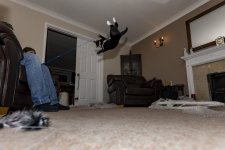Thanks for this Phil, flash is something I've never dabled in but I'll have a read of this and have a mess around. Work has been pretty tough this week and got some other stuff to prepaire for next weekend so I'll get round to reading when my head is a little less full

edit: had a quick read
Are we saying that I can capture a fast moving jumping animal by using a slower shutter speed/longer exposure than I have been by utilising the flash/second curtain sync? would be useful as at the moment I'm having to ramp my ISO up and set very high speeds to deal with the movement of the cat.
This one was shot at 1/2500 of a second, ISO-1600 F2.8. To be honest the most difficult thing is the autofocus locking on initially then and tracking, so having shots exposed with the flash would help me monitor/learn/refine that as well. One of the toughest subjects I've ever tried to photo i must admit.
View attachment 384319



